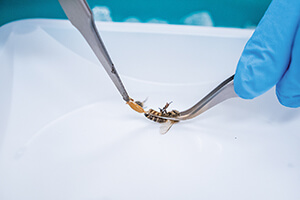
EFB might be the lesser of two foulbroods, but it is foul all the same
Opening a hive that smells sweet with honey stuffed in every cranny is among the most pleasant sensations. But unless you’re a very lucky beekeeper, you also know the dreadful feeling of being greeted with the sick stench of rotting larvae.
You might say a little prayer, hoping it isn’t American foulbrood. Unfortunately, the most likely alternative disease, European foulbrood (or EFB, caused by the bacterium Melissococcus plutonius), is also an awful affliction.
It took me four years of beekeeping before I became familiar with EFB, although I likely crossed paths with it earlier and just didn’t know what I was looking at. In my region, the sad, smelly, flaccid larvae usually show up in the spring and early summer. EFB is everywhere, I was told. Even the healthy colonies have it, and symptoms only manifest if the colony is under additional stress.
EFB is indeed a prevalent disease, but it isn’t exactly omnipresent. According to Canada’s national honey bee health survey, which ran from 2014 to 2017, about one third of sampled colonies in Alberta, for example, were positive for EFB based on molecular methods. Meanwhile, only about one in 370 colonies actually showed visible signs of disease. In the same province, the economic impact of an infection is estimated at CAD $384-607 per hive.1
This prevalence of asymptomatic carriers may lead one to think that properly isolating, treating, and disinfecting equipment taken from symptomatic colonies might not be so critical. Furthermore, the bacterium does not form hardy spores the way that Paenibacillus larvae, the causative agent of American foulbrood (AFB), does. However, EFB is a tough pathogen, too, and deserves to be taken more seriously.
The starvation hypothesis
EFB has long been thought to be a disease induced by nutritional stress — an idea that can be traced back to work conducted by H.L.A. Tarr in 1936.2 Tarr discovered that an EFB infection could be induced simply by starving larvae for several days. But it wasn’t until 1956, when Leslie Bailey figured out how to culture the bacterium, at the time known as Bacillus pluton (what we now know as M. plutonius), that more detailed investigations of the causative agent and the disease could be conducted.3
Bailey, too, postulated that the disease is linked to larval nutrition. He observed that colonies were most susceptible when the ratio of nurse bees to larvae was low, as is typical in the spring and early summer during rapid population growth. Furthermore, infected colonies could overcome the disease if the number of nurse bees was boosted.
But there could be more to the role of nutrition than just whether the larvae are sufficiently fed. New research by Marylaure de la Harpe and colleagues shows that queen and worker jellies have bactericidal activity against M. plutonius, and different strains of M. plutonius have different levels of resistance to the jellies.4 Other researchers have suggested that antimicrobial compounds in pollen5,6 and the pollen’s pH7 may play a role in disease susceptibility.
The exact mechanism of infection is still unknown, and we don’t yet understand all of the factors that increase a colony’s risk of infection, but that doesn’t mean there’s nothing that can be done to prevent it. The worst EFB year I had, for example, was when I was running a field experiment on a tight schedule, starting with splitting colonies into a few dozen experimental nucs in the spring. Spring growth was off to a slow start, and the donor colonies weren’t yet big enough to be so heavily split. I made the poor choice to split them anyway to stick to the schedule. This created the perfect conditions for EFB to pop up, despite the nucs having all-you-can-eat patties and syrup, because of the very low nurse-to-larva ratio. If I had waited another few weeks, I would have had healthier bees.
Is EFB really everywhere?
EFB is not everywhere, although in some regions it might feel like it is. In the 2017 Canadian national honey bee survey, none of the 42 samples taken from Manitoba came back positive for EFB by molecular diagnostics (qPCR), which is the most sensitive method around. By contrast, 57% of samples taken from Prince Edward Island were positive, illustrating how disease prevalence can vary dramatically depending on the region. Thankfully, it doesn’t take much distance to have an effective buffer between you and your neighbors.
In 2006, researchers in Switzerland mapped EFB incidence in colonies with different proximities to symptomatic apiaries to look into the relationship between transmission and distance between colonies.8 They analyzed samples from 80 colonies spread amongst 13 apiaries, and found that 90% of colonies without symptoms, but which were within apiaries with symptomatic colonies, also carried the pathogen. Furthermore, in apiaries that did not have symptomatic colonies themselves, but were near (within 0.31-0.62 miles, or 0.5-1 km) affected apiaries, 30% of colonies tested positive. Only apiaries with no symptomatic colonies and which were > 0.62 miles from infected colonies did not carry the pathogen.
This is why isolating infected colonies, once they are detected, is so important. The sick yard does not need to be a huge distance from other colonies in order to effectively quarantine them, but it does need to be ready to receive colonies. I learned the hard way that a sick yard should be set up well before you find out that your colonies need it, when, for the first time, I started finding EFB in my research colonies.
I used to maintain colonies at three different apiaries in the Vancouver area, but didn’t have a designated “hospital,” so when I started finding the disease in one of my yards, I desperately tried to ….


